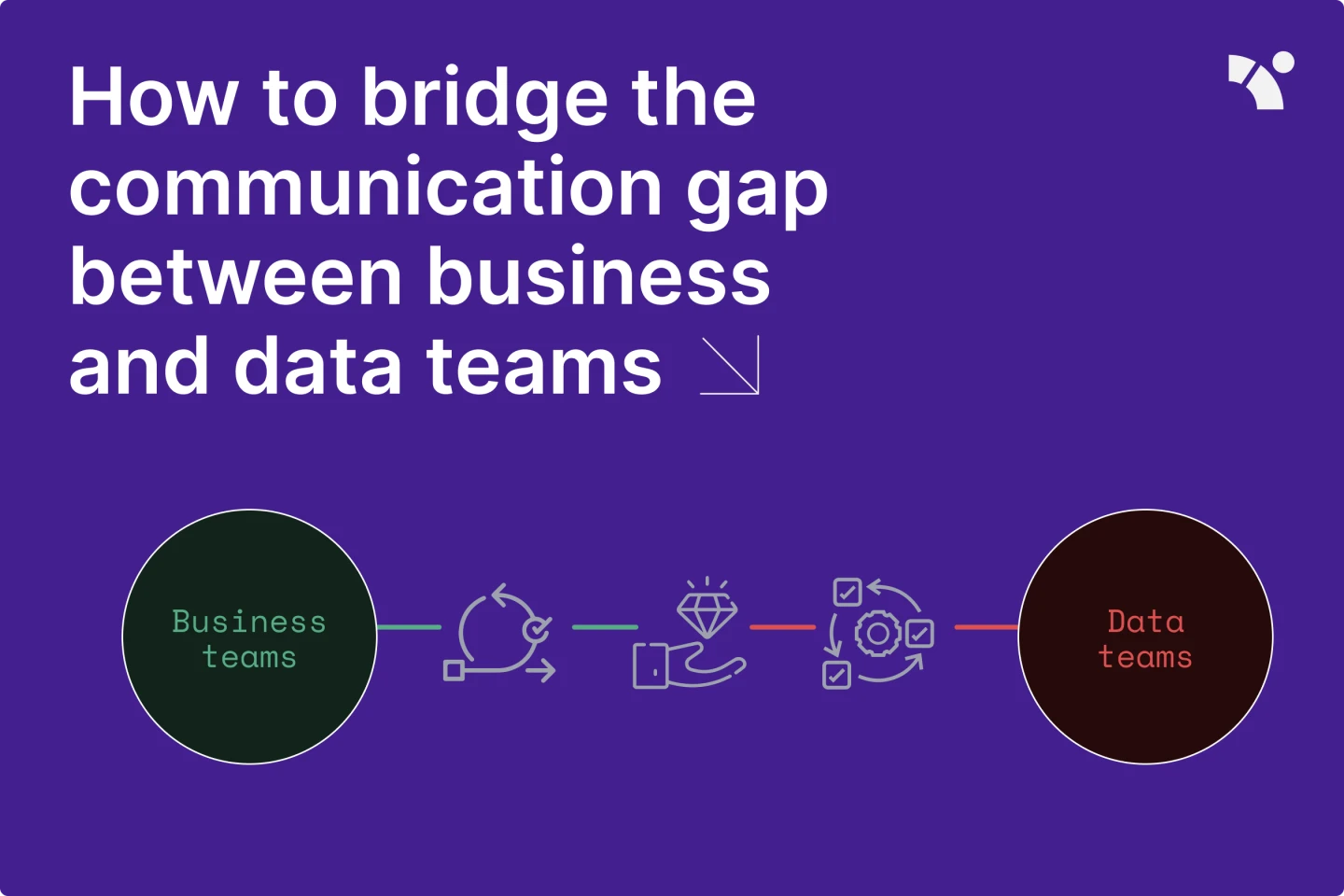If you’ve ever worked on a data team, or even on a business team that heavily relies on a data team, you know there can often be communication issues.
I’ve been in this situation one too many times, where the data and business teams are not on the same page. This could mean a team tracking analytics using a separate external platform, different from your warehouse, or the data team deleting a dashboard they thought was no longer relevant to the business.
A disconnect between business and data teams makes simple processes much harder and longer than they need to be. Things that should take weeks to complete end up taking months because of the lack of proper communication. Or, even worse, there are too many conversations where thoughts are being repeated because objectives are not properly aligned.

While this is a difficult problem to solve, it can be done. Keep reading if you want to learn how to bridge the communication gap between data and business teams.
What disconnect looks like
The disconnect between business and data teams can manifest in a few different ways. Here are some of the most common ones I’ve experienced as an analytics engineer.
Multiple “sources of truth”
Identifying one source of truth for the data within a business is the most important goal for any data team.
When there is one source of truth, numbers across multiple teams all match up. It makes it easy to rely on data rather than questioning every single conflicting source.
However, this is a hard goal to reach when your organization doesn’t have a mature data culture. This type of disconnect could look like ingesting Facebook and Google data directly into Snowflake while other marketing campaign data is coming from Google Sheets. There may also be some external platform that is being used to make decisions, but whose data is never even making it into the data warehouse.
This occurs because business teams are looking for answers in the data available to them in different ways, and the data team doesn’t fully understand how. To them, tracking everything in Google Sheets might make the most sense. However, from the data team’s perspective, we know this approach is very prone to human error. It’s not an automated solution we can rely on.
If there are manual processes being used within your organization, such as manual entry sheets and emails throwing around numbers, chances are you need an all-in-one data platform that centralizes your data sources and bridges the gap between teams — a tool like Y42.
Lack of communication with major process changes
Oftentimes, business teams don’t realize when data teams need to be involved in a conversation, and vice versa.
An example could be if marketing disables all campaigns on an advertising platform and doesn’t notify the data team, creating a false alert. Another could be a product launch without any thought to the data that needs to be collected around the launch. It’s hard to realize who needs to be involved in which processes when teams are siloed.
It’s important for both the data and business teams to know how one another’s actions affect each other. Business teams might not realize that changing any type of data source could break production models and cause false alerts. Meanwhile, data teams might not realize that changing key data models or altering the data ingestion pipeline could change how metrics are tracked. Teams need to effectively communicate what they are working on and how this could affect one another’s responsibilities.
Misaligned priorities or goals
Business and data teams are often misaligned on their priorities and future goals.
One may consider a certain initiative as a top priority, while the other team thinks something else is more important. This often stems from a deeper communication issue where teams don’t properly understand the value of one another’s work. If this is the case, teams will never consider other people’s goals as being as important as their own.
Business teams may want their ad-hoc requests to be prioritized over long-term efforts, like data quality initiatives. However, when performing ad-hoc requests, it becomes hard to prioritize foundational efforts such as moving away from spreadsheets, rebuilding data models, and standardizing columns. In this case, if the value proposition isn’t reframed in a way that enables other teams to digest it, there will always be competing priorities. This is why goals always need to be reframed in a way that is valuable for all stakeholders involved.
Different ways to bridge the disconnect
In my experience, the disconnect between data and business teams can be solved if your communication is clear and you set up organizational systems to prepare you for success.
These are my top tips for working out your differences with the commercial teams.
Present the value of the work you are doing as a data team
As a data team, you need to present the value of your work in a way that business teams will understand.
Saying you are focusing on “data quality initiatives”, for example, will mean nothing to other teams. Instead, let them know you are implementing tools and checks that will allow you to find data issues at the source so that they don’t create downtime in the dashboards they use every day. This provides value to them because now they will no longer have to contact the data team when a dashboard is down or wait for it to be fixed in order to move forward with their goals. Business teams will have a much easier time getting on board with this initiative when they know how it directly affects them.
A good way to communicate with business teams is to explain the issues occurring now and how the work you want to do will prevent them from happening in the future. This helps business teams understand the immediate impact that can come from the data team’s work outside of ad-hoc requests.
I highly recommend creating a #data-insights slack channel to showcase accomplishments and educate business teams on your data stack. My team recently implemented this and it helped us gain a lot of appreciation and understanding for our hard work.
Create systems that allow for easier communication
Cross-team communication is hard. You need to put systems in place to make it easy.
Teams need to know exactly where to look and what to do when they need something from one another. Think about what you can do to bridge the gap between teams.
One way my team has done this is by sending bi-weekly release emails. In each of these emails, we list our major accomplishments from the previous two weeks and frame the value from a business perspective. We also include what we are working on in the upcoming sprints so teams know what to expect in that time frame. This communicates our long-term goals to outside teams and how they are affecting the rest of the business in a positive way.
As a team, we’ve also created an intake form for business teams to fill out when they have an ad-hoc request. This is a pre-made form with very specific questions so we can get all the information we need to do our jobs without constant back-and-forth communication. It also forces business users to think twice about what they are asking for, prioritizing only the most important requests.
Lastly, I highly recommend creating a content calendar so your data and marketing teams are always on the same page. This will make it easy for the analytics engineer to change data quality checks depending on the data sources being used and disabled. It will also act as a great cross-reference in the case of receiving an alert that data volume is low. A calendar creates clear communication without having to go back and forth trying to identify the cause of an issue.
Adopt the SCRUM framework
Lastly, adopting the SCRUM framework will help you minimize ad-hoc requests and prioritize foundational data work, like building models, creating dashboards, and increasing data quality.
If you are unfamiliar with SCRUM, according to scrum.org, it’s “a framework within which people can address complex adaptive problems, while productively and creatively delivering products of the highest possible value”. One of the big components of this system is assigning specific tasks to certain sprints before they begin. This means that someone cannot throw a new, urgent task at you while in the middle of a sprint. They must wait until the sprint is over to then assess its priority compared to other tasks.
This system forces business teams to think weeks and months ahead about their future requests for the data team. They are forced to respect the timeframe that the data team is working on, and consider if their ad-hoc request really is a priority.
Most times, they end up solving the issue on their own or realizing that it’s actually not that important. This ends up helping both teams because the scope of work is properly assessed before jumping right into the task, leading to less burnout from the data team.
Conclusion
Communication between business and data teams will never be perfect. There will always be some sort of disconnect, especially when you’re each so focused on your goals, trying to find success as an organization. Just make sure you are continuously moving in the right direction and improving how you work with one another to bridge your communication gaps.
Adopting a collaborative end-to-end data platform like Y42 as your single source of truth is a great start.
When business teams ask you to add a new data source to the warehouse, that’s a sign you are doing something right. And when business users show interest in data education, you have something special happening.
Business and data teams working together smoothly massively impacts your organization as a whole. It will save each team valuable time, allowing people to do the work that really matters to them. It will produce more reliable insights, helping the business grow to new heights. And, it will make room for you to build on all that you’ve already accomplished, allowing you to achieve even more amazing results. So make sure you put in the effort to make this ideal scenario your reality.
Category
In this article
Share this article

